This particular aircraft was built around 1986. The plan used was published
in April 1976 Aeromodeller (repeated in March 1985). It appears that this
plan differs from Peter Cock’s original, particularly with respect to
the fuselage construction. Click here to go
to the plans page.
The overall weight of the model and its balance point will depend to a great
extent on the construction of the fuselage.
This particular model uses a fuselage of ¼ inch balsa sandwiched between
1/32 inch plywood. The overall weight is 514g, approximately 75g more
than the weight quoted for the original. As most of this extra weight
is in the fuselage, the aircraft is very tail heavy. It would only fly
with the spinner of the ED Comp Special filled with lead, adding approx 60g
to the overall weight.
This page shows the sequence of changing the nose of Kan Doo so that the aircraft
would balance without extra lead ballast in the engine’s spinner.
Aircraft original specification |
| Wing chord |
178 mm |
| Balance point for the Aircraft in flying trim |
42 mm from leading edge
24% chord |
| Weight of ED Comp Special with ED 9 ½ x 7 airscrew |
178 g |
| Weight of bare airframe |
300 g |
| Weight of fuel tank |
38 g |
| Weight of PAW 1.49 with 7 x 6 airscrew |
118 g |
| ED Comp Special is mounted 133 mm ahead of the airframe C/G |
|
| So PAW must be mounted 133 x 178/118 = 200 mm ahead of C/G |
This figure can be reduced to 185 mm when the weight of the extra mounting
is taken into account. |
| |
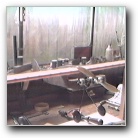 |
This is the aircraft in its original form having the balance point accurately
determined in flying trim. This was found to be 42mm from the leading
edge and was used for all subsequent re-design calculations |
| |
 |
With the fuselage clamped into a "Workmate" the new engine bearers
are fitted. The extension forward is about 35 mm. |
| |
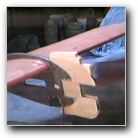 |
New balsa and ply built up around the extended engine bearers.
|
| |
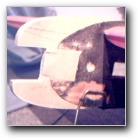 |
And the wood is shaped to produce a shape in sympathy with the original
lines.
|
| |
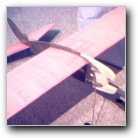 |
View of the overall "effect" |
| |
 |
Fuselage has been filled, smoothed and repainted. |
| |
 |
View of the overall effect. |
| |
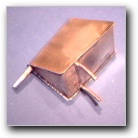 |
A new and slightly smaller fuel tank. The pipes were silver soldered
into the framework before the two parts were soft soldered together.
This makes the initial setting up of the parts a little harder but greatly
simplifies the final soft soldering. Click here
to go to the plans page
The weight saving was 12 g. |
| |
 |
The extended engine mounting for the PAW 1.49. The four "inboard"
mounting holes fit the ED Comp Special so this engine can still be used
for display flying but, due to its age, will not perform stunts.
|
| |
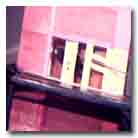 |
This is a revised exit for the elevator control rod. Originally
it was just pushed through the paper covering |
| |
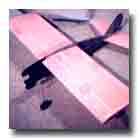 |
Airframe completed and the damage to the tissue covering on the wings
caused by all the modifications has been patched up. |
| |
 |
General view of the nose of the aircraft with the new fuel tank mounted
somewhat further forward than the original and nearer to the C of G.
No fuel tubing fitted as diesel tubing is difficult to find. |
| |
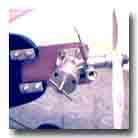 |
Close up of the aircraft with the PAW 1.49 mounted. Either this
engine or the ED Comp Special will balance the aircraft in exactly the same
point. |












